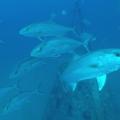When to Remove Fish
When to Remove Fish
When the pond is new, you need to release all of the bass that are caught the first and second years of fishing. By the third year, harvest 15 pounds of bass per acre per year from ponds that are not fertilized.
In naturally fertile or fertilized ponds, this number must be doubled to account for the increased production. Harvest primarily small bass less than 14 inches, and release intermediate-sized bass (14 to 18 inches). This will ensure rapid growth of bass and an adequate number of bass for reproduction, and it will also control bream.
In most cases, after the first year of fishing, you can remove bream as desired with little risk of harming the population. It is practically impossible to take out too many bream, as ponds can support at least 45 pounds of harvest per acre.
Try to spread the harvest out over the course of the year. Keep a record of fish harvested, and ask others who fish the pond to tell you the number and size (at least length) of bass and bream they remove from the pond. At the end of the year, tally the harvest to determine if you are reaching your harvest goal.
If the pond is stocked with channel catfish, spread the catfish harvest over 3 to 4 years. Channel may reproduce in ponds, but offspring usually do not survive because of bass predation. Restock with channel catfish when 60 percent of the originally stocked catfish have been removed. Restock with 8- to 10-inch channel catfish fingerlings to ensure the bass do not quickly consume these fingerlings.
News
BILOXI, Miss. -- The Southeast has some of the most commercially and recreationally valuable fisheries in the United States.
Fisheries experts at Mississippi State University and other research institutions are conducting an $11.7 million study of the greater amberjack, an important recreational and commercial species in the South Atlantic and Gulf of Mexico that is threatened by overfishing.
Grandpa cast the jig and cork to the center of the pond and handed it to Lucy. “Now, start reeling in slowly,” he said.




